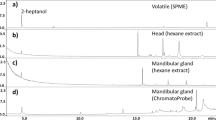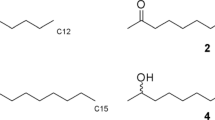Abstract
We investigated the chemistry of Dufour’s gland secretions in Formica argentea Wheeler (Hymenoptera: Formicidae: Formicinae), an understudied species common in the Western and Midwestern United States and Canada. Gas chromatography–mass spectrometry reveals that undecane is the most prominent component in this ant’s Dufour’s gland extracts. Behavioral bioassays show that exposure to the compound significantly increases activity level in workers but does not act as a trail pheromone. This suggests an alarm function for undecane, which is consistent with other species of Formica. Taken with previous research, these findings provide evidence for evolutionary analyses of this character in this family of insects.


Similar content being viewed by others
References
Ali MF, Morgan ED (1988) Chemical communication in insect communities—a guide to insect pheromones with special emphasis on social insects. Biol Rev Camb Philos Soc 65:227–247
Ali MF, Attygalle AB, Morgan ED, Billen JPJ (1987) The Dufour gland substances of the workers of Formica fusca and Formica lemani (Hymenoptera, Formicidae). Comp Biochem Physiol B-Biochem Mol Biol 88:59–63
Andryszak NA, Payne TL, Dickens JC, Moser JC, Fisher RW (1990) Antennal olfactory responsiveness of the Texas leaf cutting ant (Hymenoptera: Formicidae) to trail pheromone and its two alarm substances. J Entomol Sci 25: 593–600
Bagnéres AG, Morgan ED, Clement JL (1991) Species specific secretions of the Dufour glands of 3 species of Formicine ants (Hymenoptera, Formicidae). Biochem Syst Ecol 19:25–33
Bennett B (1987) Ecological differences between monogynous and polygynous sibling ant species (Hymenoptera, Formicidae). Sociobiology 13:249–270
Bestmann HJ, Janssen E, Kern F, Liepold B, Hoelldobler B (1995) All-trans Geranylgeranyl acetate and geranylgeraniol, recruitment pheromone components in the dufour gland of the ponerine ant Ectatomma ruidum. Naturwissenschaften 82:334–336
Bestmann HJ, Kern F, Schäfer D, Witschel MC (1992) (R)-3,4-Dihydroisocoumarins, a new class of ant trail pheromone. Angew Chem Int Ed Engl 31:795–796
Bestmann HJ, Übler E, Hölldobler B (1997) First biosynthetic studies on ant trail pheromones. Angew Chem Int Ed Engl 36:395–397
Blatrix R, Schulz C, Jaisson P, Francke W, Hefetz A (2002) Trail pheromone of ponerine ant Gnamptogenys striatula: 4-methylgeranyl esters from Dufour’s gland. J Chem Ecol 28:2557–2567
Bono JM, Blatrix R, Antolin MF, Herbers JM (2007) Pirate ants (Polyergus breviceps) and sympatric hosts (Formica occulta and Formica sp cf. argentea): host specificity and coevolutionary dynamics. Biol J Linn Soc 91:565–572
Emery C (1925) Hymenoptera. Fam. Formicidae. Subfam. Formicinae. Genera Insectorum 183:1–302 [combination in F. (Serviformica)]
Errard C, Hefetz A, Jaisson P (2006) Social discrimination tuning in ants: template formation and chemical similarity. Behav Ecol Sociobiol 59:353–363
Guerrieri FJ, d’Ettorre P (2008) The mandible opening response: quantifying aggression elicited by chemical cues in ants. J Exp Biol 211:1109–1113
Hefetz A, Lenoir A (1992) Dufour’s gland composition in the desert ant Cataglyphis—species specificity and population differences. Z Naturforschung C 47:285–289
Hillery AE, Fell RD (2000) Chemistry and behavioral significance of rectal and accessory gland contents in Camponotus pennsylvanicus (Hymenoptera: Formicidae). Ann Entomol Soc Am 93:1294–1299
Hölldobler B, Wilson EO (1990) The ants. Springer, Berlin, p 263
Howard RW, Blomquist GJ (2005) Ecological, behavioral, and biochemical aspects of insect hydrocarbons. Ann Rev Entomol. Annual Reviews, Palo Alto, vol 50, pp 371
Keegans SJ, Billen J, Morgan ED (1991) Volatile secretions of the green tree ant Oecophylla smaragdina (Hymenoptera, Formicidae). Comp Biochem Physiol B-Biochem Mol Biol 100:681–685
Morgan ED (2009) Trail pheromones of ants. Physiol Entomol 34:1–17
Ottoni E (2000) EthoLog 2.2: a tool for the transcription and timing of behavior observation sessions. Behav Res Methods Instrum Comput 32(3):446–449
R Development Core Team (2005) R: a language and environment for statistical computing, reference index version 2.x.x. R Foundation for Statistical Computing, Vienna, Austria. ISBN 3-900051-07-0, URL: http://www.R-project.org.
Regnier FE, Wilson EO (1969) Alarm-defence system of ant Lasius alienus. J Insect Physiol 15:893–897
Showalter DN, Troyer EJ, Aklu M, Jang EB, Siderhurst MS (2010) Alkylpyrazines: alarm pheromone components of the little fire ant, Wasmannia auropunctata (Roger) (Hymenoptera, Formicidae). Insectes Sociaux 57:223–232
Snyder LE (1993) Non-random behavioural interactions among genetic subgroups in a polygynous ant. Anim Behav 46:431–439
van der Meer RK, Alonso LE (1998) Pheromone directed behavior in ants. In: van der Meer RK, Breed MD, Winston ML, Espelie KE (eds) Pheromone communication in social insects. Westview Press, Oxford, pp 159–192
van der Meer RK, Preston CA, Choi MY (2010) Isolation of a pyrazine alarm pheromone component from the fire ant, Solenopsis invicta. J Chem Ecol 6:163–170
Wheeler WM (1902) The occurrence of Formica cinerea Mayr and Formica rufibarbis Fabricius in America. Am Nat 36:947–952
Wheeler WM (1912) New names for some ants of the genus Formica. Psyche (Camb) 19:90 [replacement name]
Wheeler WM (1913) A revision of the ants of the genus Formica (Linné) Mayr. Bull Mus Comp Zool 53:379–565 [queen, male described]
Wilson EO, Regnier FE (1971) The evolution of the alarm-defense system in the Formicine ants. Am Nat 105(943):279–289
Witte V, Attygalle AB, Meinwald J (2007) Complex chemical communication in the crazy ant Paratrechina longicornis Latreille (Hymenoptera: Formicidae). Chemoecology 17:57–62
Yamagata N, Fujiwara-Tsujii N, Yamaoka R, Mizunami M (2005) Pheromone communication and the mushroom body of the ant, Camponotus obscuripes (Hymenoptera: Formicidae). Naturwissenschaften 92:532–536
Acknowledgments
Thanks to Barbara Demmig-Adams for her valuable help and support in initiating this research. This project was funded by a grant from the Undergraduate Research Opportunities Program at University of Colorado-Boulder.
Author information
Authors and Affiliations
Corresponding author
Rights and permissions
About this article
Cite this article
Lenz, E.L., Krasnec, M.O. & Breed, M.D. Identification of Undecane as an Alarm Pheromone of the Ant Formica argentea . J Insect Behav 26, 101–108 (2013). https://doi.org/10.1007/s10905-012-9337-5
Revised:
Accepted:
Published:
Issue Date:
DOI: https://doi.org/10.1007/s10905-012-9337-5




